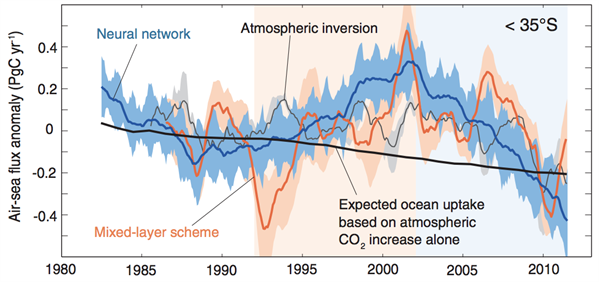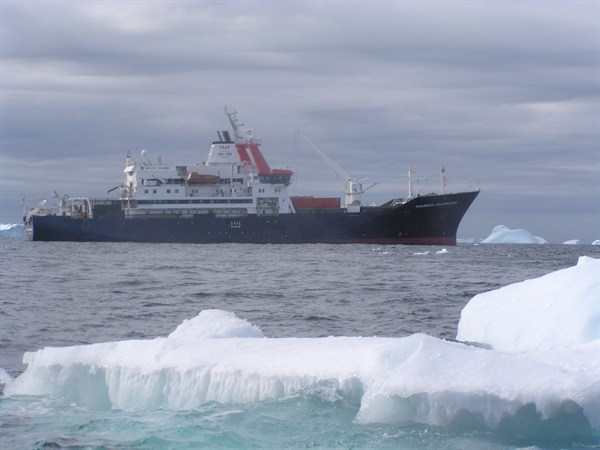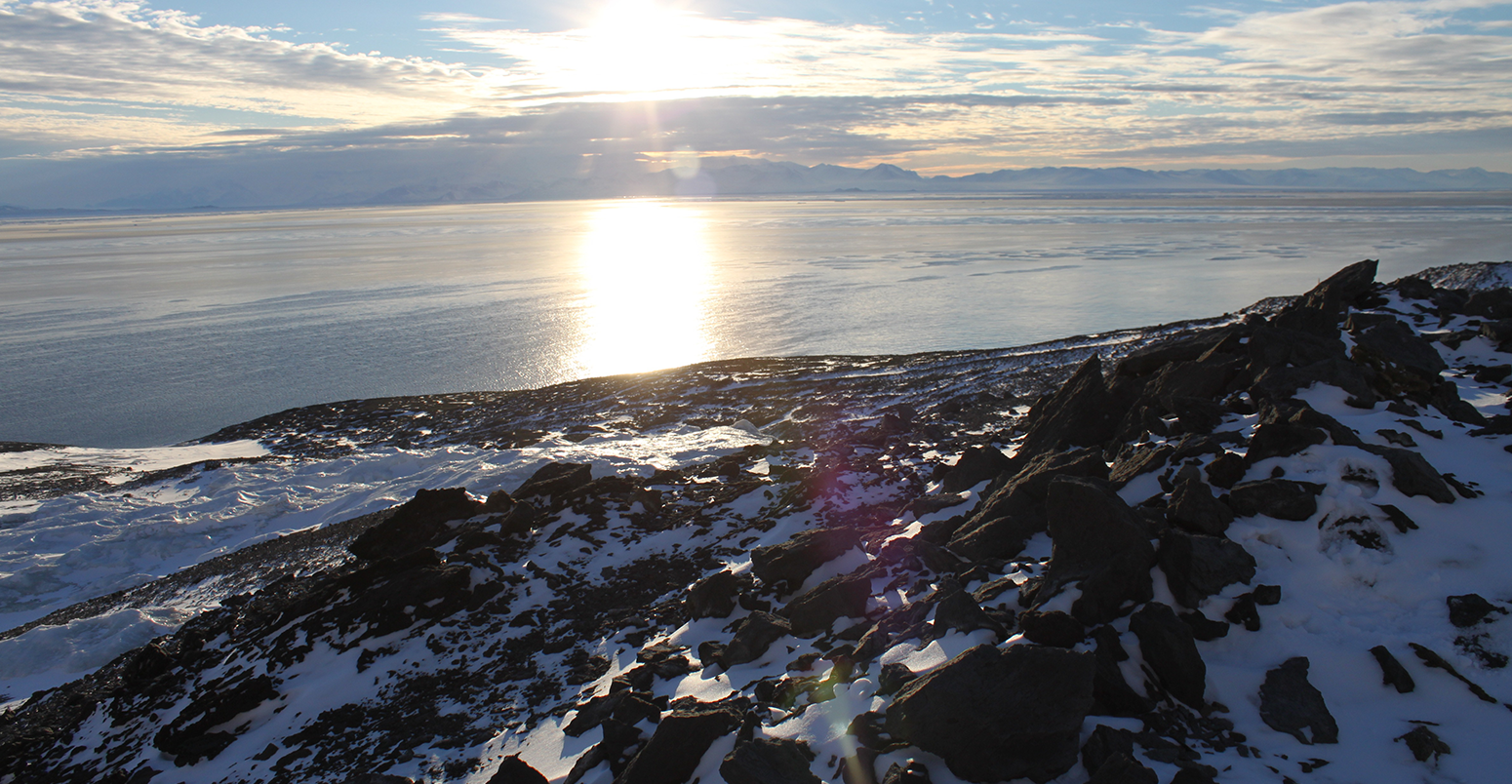Southern Ocean carbon sink bounces back with renewed vigour, study says
Robert McSweeney
09.10.15Robert McSweeney
10.09.2015 | 7:00pmThe Southern Ocean takes up more carbon dioxide than any other body of water on our planet. Though in recent decades, this uptake has shown signs of slowing.
But the vast ocean surrounding Antarctica is staging a recovery, says a new study, with a resurgence in carbon absorption that more than makes up for the earlier sluggish period.
Although this seems like good news, it’s not guaranteed to last. If carbon uptake slows again in future, this could lead to an acceleration of global temperature rise, the researchers say.
Carbon sink
The oceans absorb and store around a quarter of the emissions from human activities. This makes our oceans a hugely important “carbon sink”, and without them, carbon dioxide would accumulate more quickly in the atmosphere, raising temperatures more quickly.
The Southern Ocean is the most prolific of the oceans for carbon storage – accounting for around 40% of total ocean carbon uptake.
Scientists expect that as carbon dioxide levels increase in the atmosphere, the oceans will take up some of this extra burden. Prof. Nicolas Gruber from ETH Zürich, a senior author on the new study in the journal Science, explains to Carbon Brief:
But research published in 2007 showed that carbon uptake of the Southern Ocean fell between 1981 and 2004. You can see this weakening in the graph below. The blue line shows the transfer, or flux, of carbon dioxide between the ocean surface and the atmosphere. When the line goes up, it means the oceans are absorbing less carbon dioxide from the air above it. In the pale orange panel, you can see that carbon dioxide uptake decreases are largest in the 1990s.

Flux of carbon dioxide between the atmosphere and the surface of the Southern Ocean. Graph shows the main results from the statistical model used in the study (blue line), the results from an alternative method (orange line), and results based on observations from the atmosphere only (thin grey line). The thick black line shows an approximation of how scientists expected the carbon sink to increase. Negative values mean the ocean taking up more carbon dioxide. Source: Landschützer, et al. (2015).
Wind patterns
In the original study that identified the carbon sink decline, the authors attributed the drop to a shift in wind patterns around Antarctica, which affected ocean currents and brought carbon-rich water to the surface. With a smaller imbalance between the amount of carbon dioxide in the ocean and the atmosphere, this meant less of the gas was absorbed by the ocean.
Scientists linked these wind patterns to a changing climate and the hole in the ozone layer, which suggested that the carbon sink could actually decline further as climate change intensified, rather than increase.
The new study picks up where the original one left off.
Combining millions of readings of ocean carbon dioxide levels from research ships with data from satellites, the researchers developed a statistical model to map carbon uptake across the whole Southern Ocean. The new data shows that since 2002, carbon uptake in the Southern Ocean has picked up again. You can see this as the downward-sloping blue line in the pale blue panel in the earlier graph.

The research ship that collected measurements of carbon dioxide in the Southern Ocean as it travelled back and forth to Antarctica. Credit: Nicolas Metzl.
Two different mechanisms
So, what caused this recovery since 2002?
The researchers found that the winds had not simply reverted back to how they were before the 1980s, but instead changed again. Rather than blowing in a roughly-circular pattern as they travelled clockwise around the Antarctic land mass, the winds now bulged out, creating almost a figure-of-eight shape, though not crossing in the middle.
This had different impacts in the Pacific and Atlantic sides of the Southern Ocean.
On the Pacific side, the winds pulled cold air from Antarctica and over the ocean, causing the surface temperature of the ocean to drop. Gruber explains:
On the Atlantic side, the winds suppressed the upwelling of carbon-rich water. With less carbon at the surface, the water absorbed more from the atmosphere. This is the opposite to what happened in the 1980s and 1990s.
Despite the different effects, the outcome was the same, says Gruber:
Fluctuations
In an accompanying perspectives article, Dr Sara Mikaloff-Fletcher, from the National Institute of Water and Atmospheric Research in New Zealand, points out that although the study shows what has happened in the past, scientists still aren’t clear on how the Southern Ocean carbon sink will respond to climate change in future.
Without a crystal ball to hand, Gruber says he doesn’t think it will be long before things change again:
Prof. Corinne Le Quere, director of the Tyndall Centre for Climate Change Research and lead author of the study that found the original decline, stresses the importance of understanding the causes of the wind changes:
What the findings do show is how intricately linked the Southern Ocean carbon sink is to changes in climate, the researchers conclude. And if it again loses its strength, it would lead to a faster accumulation of carbon emissions in the atmosphere, and more rapidly-increasing temperatures.
Main image: View of the Southern Ocean of the coast of Antarctica. Hut Point Loop Hike. Credit: Eli Duke/Flickr.
Landschützer, P. et al. (2015) The reinvigoration of the Southern Ocean carbon sink, Science, doi/10.1126/science.aab2620 & Mikaloff-Fletcher, S.E. (2015) An increasing carbon sink? Science, doi/10.1126/science.aad0912.
-
The Southern Ocean takes up more CO2 than any other body of water on our planet. But this uptake has shown signs of slowing.


